The story of women's football in 10 objects
- Published
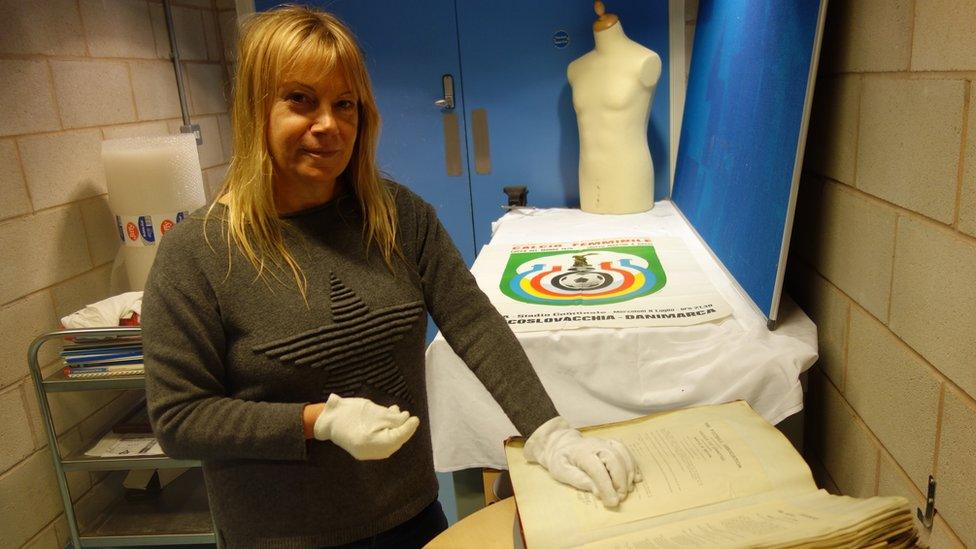
Prof Jean Williams with the original minutes from 1921 which banned women's football in FA grounds
A hundred years ago, teams of women were playing in front of large crowds and making big money. Then the Football Association banned them from its grounds. Here's the story of the fall and rise of women's football, told through 10 objects collected by the National Football Museum.
"Complaints having been made as to football being played by women, the [FA] council feel impelled to express their strong opinion that the game of football is quite unsuitable for females and ought not to be encouraged. Complaints have also been made as to the conditions under which some of these matches have been arranged and played, and the appropriation of receipts to other than charitable objects."
With these words in 1921, the FA decided to ban the playing of women's football in FA-member grounds, which strangled the game as a successful business as the stricture remained in place for 50 years. In other countries there were outright bans on women playing.
Jean Williams, the University of Wolverhampton's professor of sport, takes us through items which show the business history and struggles of the women's game.
1. 1895 Sketch magazine print of Nettie Honeyball 'in her football costume'

"In 1863 we get the formation of the Football Association and of the modern game. The first women's football games that we know about are in 1881, and they are professional games played to large audiences and they make money. It seems they are organised by local businessmen. The 1881-82 games are relatively short lived.
"Nettie Honeyball is the secretary and captain of the first British Ladies Football Club, which was founded in 1894. She was a middle class woman, and they had a non-playing president Lady Florence Dixie, who was upper class.
"In historic terms this was the first time women organised football for women. The first game was in Crouch End in 1895 before 10,000 people, which must have generated healthy receipts. Hundreds of games follow in the next few years and the women's game is played all over Britain."
2. Wheaties cereal box from the 1990s featuring US player Michelle Akers
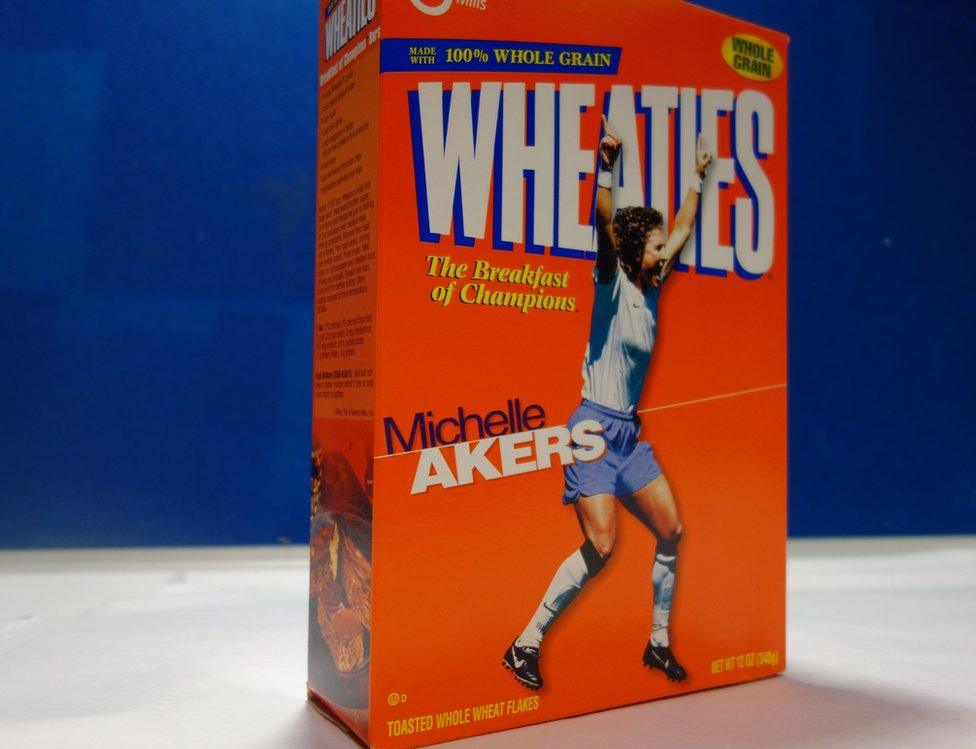
"In the 1991 women's world championship she was the winner of the golden boot. She was the first real international women's football star and was massive in the US. She paved the way for Mia Hamm and Hope Solo, but interestingly one of the things that constricted her potential success was that she suffered from chronic fatigue disorder. But for that, her international profile could have been much more.
"The narrative of the Wheaties box is that she has had challenges to overcome but is still achieving and can't be held back. This is all referred to on the packaging of the cereal, which the manufacturers call 'The Breakfast of Champions'.
"It is one of the first commercial endorsements of this type in the 1990s, at a time when Fifa finally decided they were going to actively oversee women's football, having taken over its stewardship in 1971 but not doing much to promote it in the intervening years."
3. Programmes from 1950s women's football matches
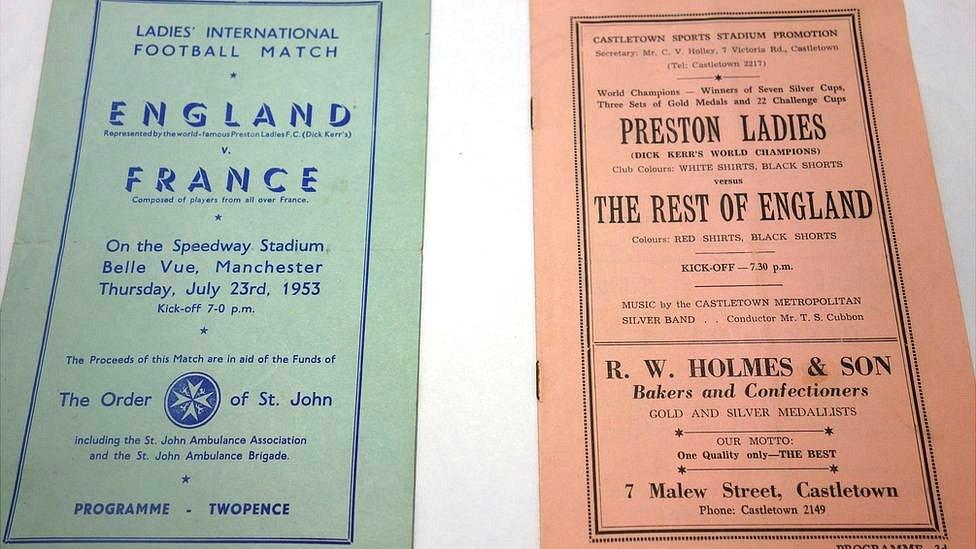
"The crux of the FA's ban is that it does not ban women's football outright, but stops it being played on member clubs' grounds. Before the ban women's football is an entertainment spectacle, and if you play it in enclosed stadiums then you can charge people money to come in and watch.
"Once the ban comes in women's football goes to other venues: to rugby league and cricket grounds, as well as other venues. These programmes show games being played at Belle Vue speedway stadium, Manchester, and at a general sports stadium on the Isle of Man.
"But the FA puts pressure on other sports not to host women's games, which destroys the business model of the women's game. And that gives growth to the myth that women's football has never been an entertaining commercial spectacle. The game is still finding its way back from the ban."
4. Christie and Barbie football dolls
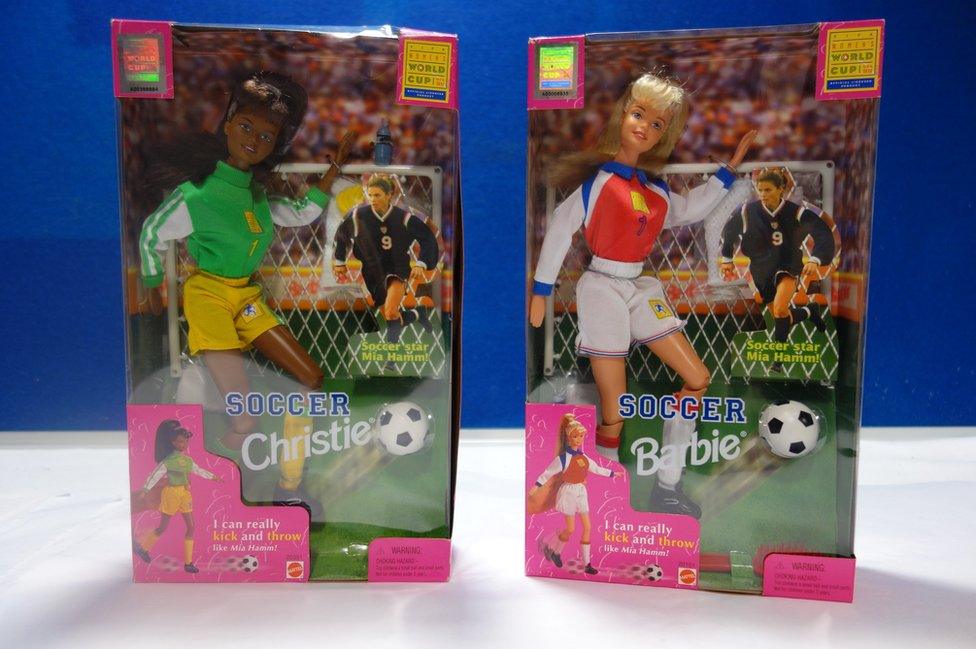
"These dolls were released for sale before the 1999 Women's World Cup by toymaker Mattel. The goalkeeper of that team was Briana Scurry." [The first woman goalkeeper and first black woman to be elected to the US National Soccer Hall of Fame.]
"But more generally, it reflects [the fact] that the American consumer market was sensitive and aware of questions of ethnicity and race. The marketing of the dolls was as diverse and inclusive as it could be.
"There was obviously already an established business around the Barbie and Christie brands, but such was the growing marketing power of women's football that a major manufacturer thought it could cash in further around the 1999 World Cup."
5. Shirt from Eniola Aluko's debut, England v Netherlands, 2004
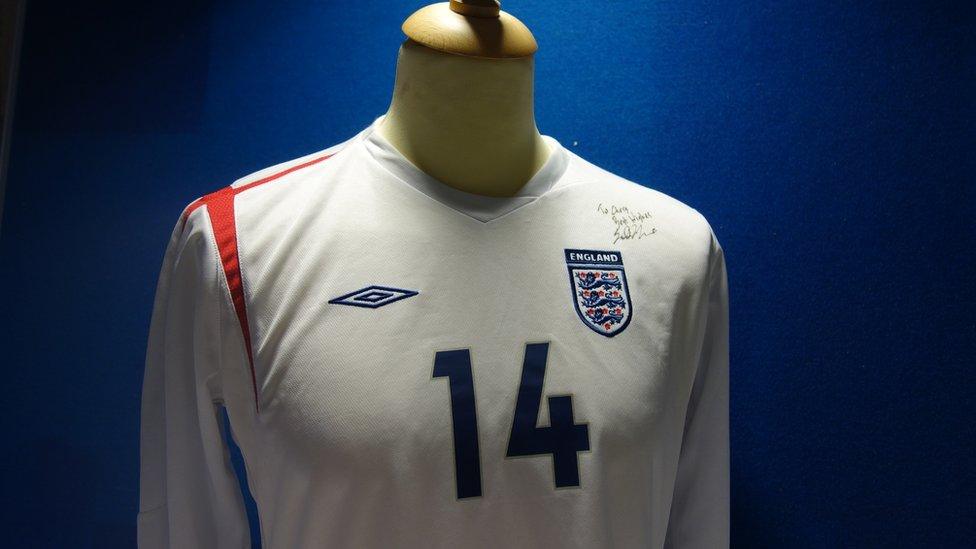
"The business significance is that major manufacturer Umbro produced the shirt. Historically, sporting brands have not created consumer markets in women's football replica wear in the same way that they have done in other sports, particularly the high-fashion ones of tennis and golf.
"It is only relatively recently that that sporting brands have released football shirts cut for women, or boots specifically made for female feet. However, while these other aspects of women's football shirts have progressed, what is interesting is that often the shirt sponsors within the game are not of such 'high brand value' as the men's game.
"There is a real opportunity out there for brands such as cosmetics firms to sponsor women's football teams, but you get brands like Nivea preferring to partner with the Liverpool men's football team."
6. A ticket from the 1991 Women's World Championship with sponsor

"This ticket, being sponsored by M&Ms, shows that a major US confectionery brand was using women's football to try and crack the potential new business market of China. The tournament was played for the M&Ms Cup. Meanwhile, China wanted to establish a commercial relationship with the West.
"There were seven sponsors of this first official women's global tournament in 1991, which Fifa interestingly, and tentatively, called a 'world championship' and not a World Cup. Fifa wanted to get into China and China wanted to join the world football family, so to test the waters this low-financial-risk event was drawn up.
"The event was a sporting success and also a successful media product, it was sold to TV companies around the world, and it showed full stadia for the women's game."
7. Ball and boots of the type worn by 1920s/30s star Lily Parr

"Lily Parr was the star of the Dick, Kerr Ladies football team of Preston. She began playing for the team at 14, and played for them for 20 years. There are various reports of Lily receiving 'broken time payments', that is, financial compensation for amateur players for time they had had to take off from their day jobs. These women players were nurses, munitions workers, and so on.
"These payments, with her earnings from nursing, enabled her to become the first person in her family to own their own home. Obviously this all relates to the ban of 1921 as the FA decides too much of the charitable funds from women's matches are being used for player expenses. They were meant to be amateurs but the financial arrangements could be described as at best opaque.
"The boots and ball are from her era. She was a left winger, then moved back into defence and ended her career in goal."
8. Poster for an unofficial Women's World Cup in 1970
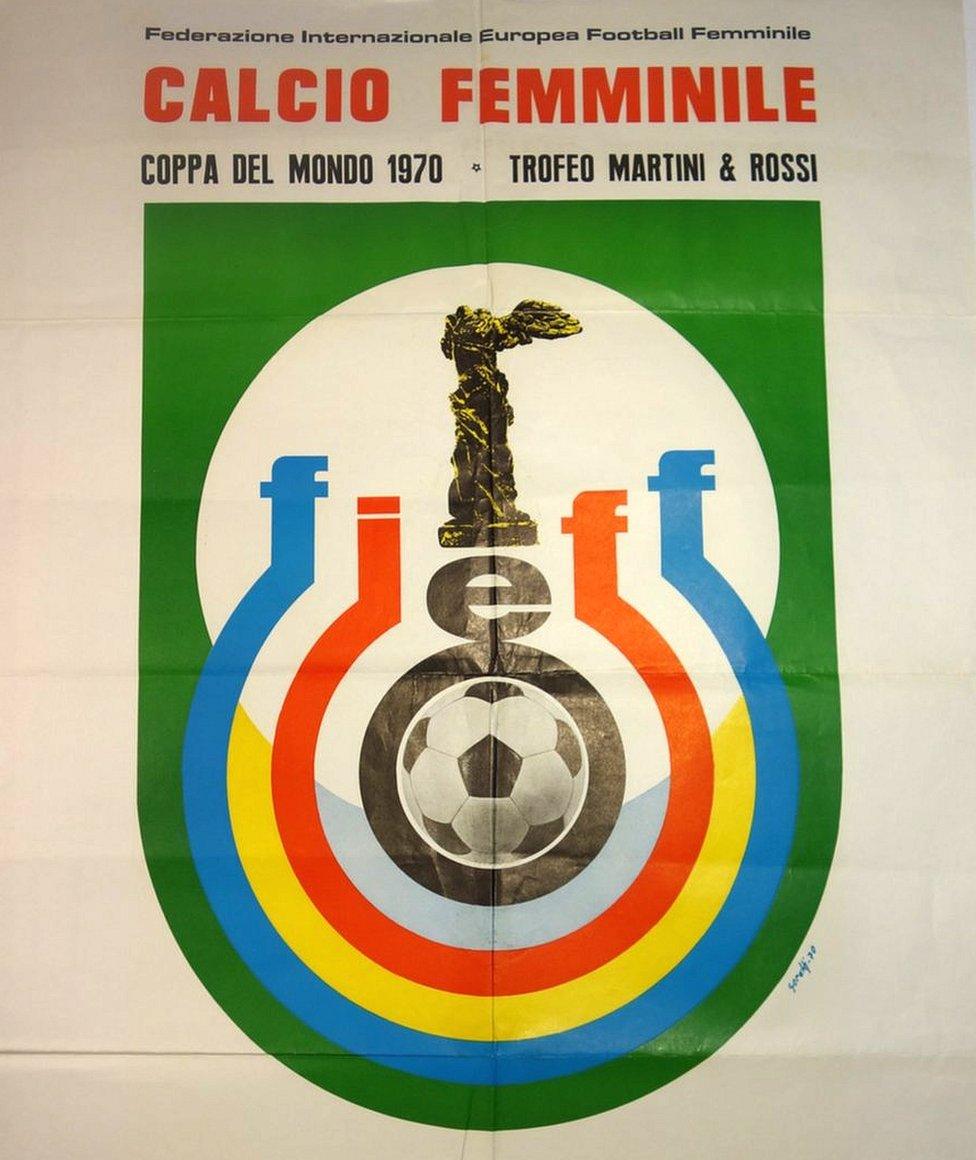
"There were two unofficial Women's World Cups held in the early 1970s: one in Italy in 1970 and one in Mexico a year later, both backed by local business interests and played in major football stadiums.
"In Mexico the event definitely looked to piggyback the men's World Cup held in the country the previous year. That would explain the commercialisation of the women's event there, which was considerable, with key rings, badges, programmes and other consumables produced, and a lot of coverage in the local press. The final was played in the Azteca Stadium in front of 110,000.
"The Italian event was sponsored by Italian multinational drinks brand Martini & Rossi, and its final was held in the Turin's Stadio Communale in front of 40,000." [Denmark defeated the host nations in both finals].
9. Postcard of Dick, Kerr Ladies FC (1920s)
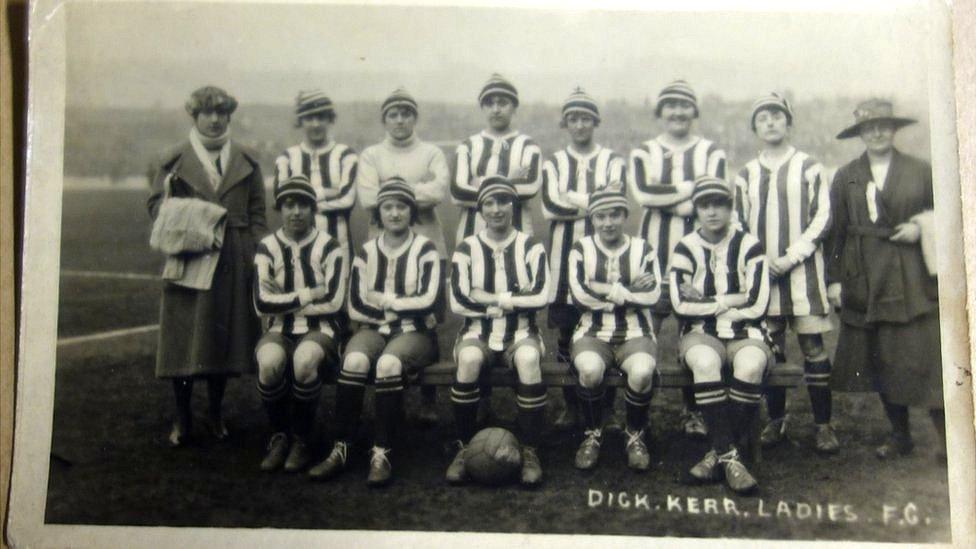
"Dick, Kerr wanted to be known as the best in the world, but also wanted to plug into the success of the local men's team and the civic notion of Proud Preston. They had a regular paying public who supported them financially at weekends but also at pioneering floodlit matches.
"Most of the crowds at their games are local working-class men. When we think we are being progressive by following women's football, it was these men who were coming out to support the team week in, week out.
"This commercially-produced postcard is evidence of 'ambient marketing', typical of how the team's fame spread beyond their home town to a much wider audience. Newsreel films and magazine articles will also have spread their name further afield."
10. Art deco statuette of a female footballer
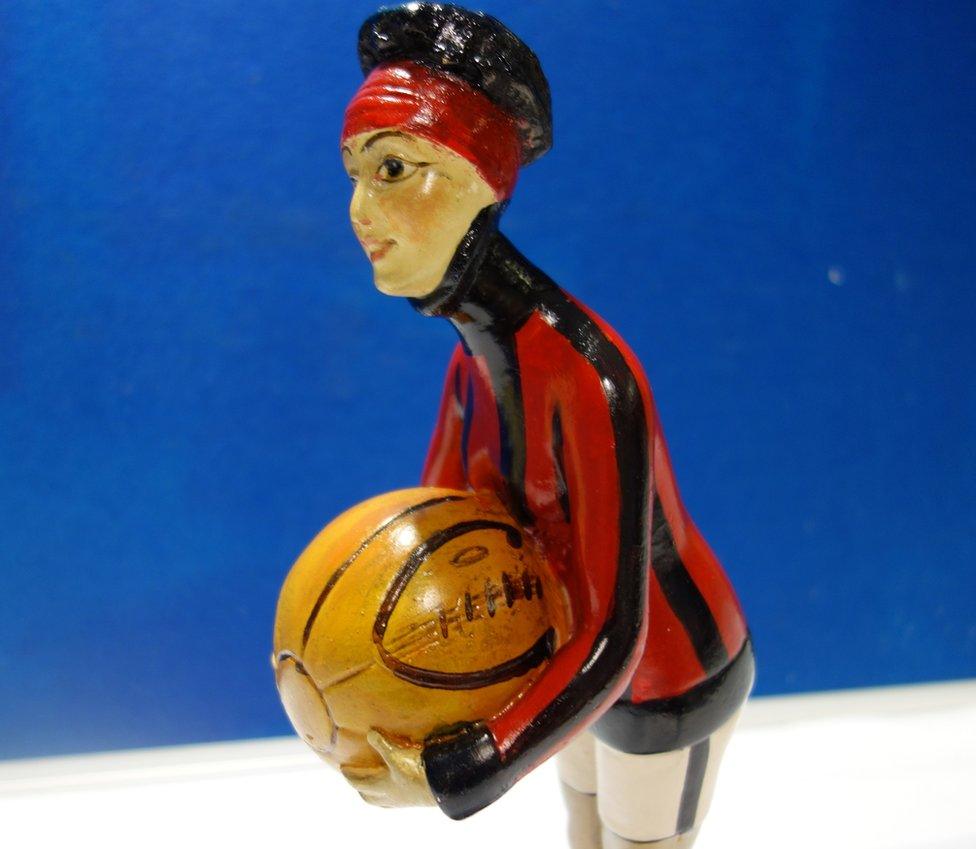
"Because women's football has always been topical, representing modernity, assertive female physicality, and - in its early days - played solely to raise large sums of money, its broader representation has always been culturally significant.
"So artefacts, collectables, disposable items, ephemera, have been created around the game over the decades. This statuette is an example of a stylised female football player that someone would have had in their home. It is 1920s in appearance.
"There were a lot of similar models made around women's boxing and athletics; beautified art deco creations."
Professor Williams has organised Upfront and Onside: The Women's Football Conference, about the history and heritage of women's football to be held at the National Football Museum in Manchester on International Women's Day, 8 March, and the following day.